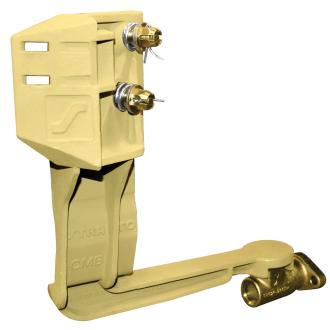Coupler Mounted Bracket – The Answer to Railcar Hose Separations on Cushioned Cars
Nearly 20,000 railcar hose separations occur per year, almost always involving a cushioned car. This results in train stoppage and costs the railroads over $7.25 million per year.
- The CMB is unconditionally approved by the AAR per the requirements of AAR S-4021, S-427 and other long shank coupler applications*.
- It can replace most E-Type end of car bracket arrangements and many others.
- It works with all end-of-train (EOT) devices.
- Will not interfere with any standard angle cock location.
- The uncoupling lever, knuckle and lock lift can be removed and replaced with bracket in place.
*For changes to arrangements beyond allowable per Rule 6, car owner approval must be obtained to install the CMB. Contact Strato for an assessment of compatibility. Care must be taken to ensure the CMB cannot connect with any carbody components. See examples.

End of trainline brackets and trolleys for cushioned railcars have long been a problem for the railroad industry. Buff or draft, straight or curved, fast or slow, the ability to prevent separations remains one of the most critical issues in the railroad industry. The variety of railcar arrangements and their differing maintenance conditions, (bent, broken, worn, etc.) make the problem even more difficult.
The trolley hose arrangement has long been recognized as the having the highest uncoupling rate, when normalized for mileage. The significant issue for the trolley arrangement is its freedom of movement. This movement has the most dramatic impact when a train goes through buff, draft or curves. During this time, all the force is transferred to the gladhand as it is required to push or pull the arrangement.
This force on the gladhand can increased by dirt, ice, weld spatter, bent rods, incorrect repairs, and other operating issues. Contrasting this force on trolley arrangement connections, cars with fixed point end hose connections have fewer hose separations because no force is put on the gladhands.
Rail industry assumptions have long held that the required force to pull apart two gladhands is 400 lbs. to 600 lbs. of pressure. Using new testing equipment that more accurately reproduces real-world conditions for trolley arrangements, Strato has determined that there is a high variation in pull apart force required to imitate a separation. In fact, we have found that separation can occur with as little as 40 lbs. to 75 lbs. under the right conditions - even when the connection is under full pressure!
It turns out that the force to pull the trolley can be greater than the force required to separate the gladhands. When these two forces overlap (force to move and force to separate) a hose separation can occur.
How it works...
The CMB maintains the trainline support casting in a fixed relationship with coupler and is no longer influenced by slack in the coupling system.
As the coupler moves from buff to draft or left to right through turns, the trainline support casting remains in a fixed position and no stress is applied to the gladhands.
Fast & Easy to Install....
The CMB clamps directly on to the coupler and can be installed in about 15 minutes.
Installation requires no jacking of the car, no measurements or welding and can be performed by a technician.
The only tools required for installation include a ratchet, 15/16” deep socket, ¾” socket, flat screwdriver and pliers or other suitable tool for bending cotter pins.
